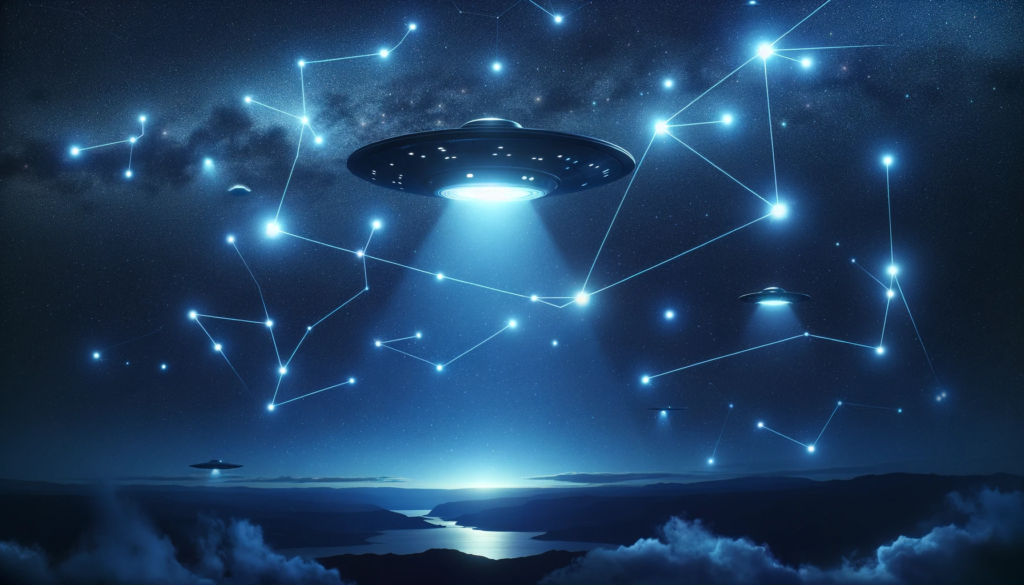Dancing Stars – UFO

The concept of UFOs or UAPs (Unidentified Aerial Phenomena) disguising themselves as stars or using the night sky to conceal their presence has been a topic of research within the UFO community. This idea stems from various observations and theories proposed by individuals and researchers in the field.
- Visual Observations and Theories: Some researchers and enthusiasts believe that UFOs have camouflaged themselves as stars within constellations for centuries. This theory posits that UFOs use advanced cloaking technology to blend in with the cosmic backdrop, often positioning themselves in configurations that imitate the shapes of constellations. UFOs are alleged to have been seen maneuvering within constellations like Ursa Major, Orion, Cassiopeia, and Scorpius. Proponents of this theory, such as UFO blogger and author Scott C. Waring, assert that certain bright stars like Sirius, Vega, and Betelgeuse could actually be massive alien motherships emitting intense light to obscure their true nature.
- Shift in Terminology and Approach: The shift from the term “UFO” to “UAP” reflects a more data-driven, scientific approach to understanding mysterious flying objects. This change is partly due to the collection of data by national security departments and civilian stargazers. The focus has shifted to hard evidence and understanding the nature of these events, utilizing advanced technologies like radar. NASA has commissioned an independent team of scientists and astrophysicists to analyze unclassified UAP data, aiming to ensure aircraft safety and better understand these phenomena.
- Literature on UFOs and UAPs: Various books have been written on the subject of UFOs, providing different perspectives and accounts. For instance, “The Roswell Legacy” by Jesse Marcel Jr. and Linda Marcel details the firsthand account of Major Jesse Marcel at the Roswell crash. “UFOs Caught on Film” by B J Booth compiles photographic evidence of UFOs. “For Nobody’s Eyes Only” by Nick Redfern investigates hidden government files related to UFOs, and “Flying Saucers and Science” by Stanton T. Friedman presents over 40 years of research on the topic. Another book, “UFOs, Chemtrails, and Aliens” by Donald R. Prothero and Timothy D. Callahan, takes a science-based approach to various claims and sightings.
These sources collectively provide insights into the ongoing exploration surrounding UFOs and UAPs, including the intriguing possibility of these phenomena disguising themselves within the night sky.
The video above I took, and I talk about all the details in my UFO and Abduction Story. To find out more, read my story.
The idea that UFOs or UAPs might mimic or camouflage themselves as stars and could potentially respond to human interaction is a topic that blends the boundaries of science and paranormal research. According to this concept:
- Imitating and Mimicking Stars: UFOs are theorized to disguise themselves as stars, using advanced technologies or natural phenomena to blend into the night sky. This camouflage might involve positioning themselves in patterns that resemble constellations or mimicking the brightness and appearance of actual stars.
- Hiding and Cloaking: Such UFOs would be employing a form of cloaking technology, effectively hiding in plain sight. This might involve manipulating light or other aspects of their appearance to become virtually indistinguishable from stars to the naked eye.
- Communication Attempts: There is a belief among some individuals that it is possible to communicate with these camouflaged UFOs through focused thought or mental effort. This idea stems from theories in parapsychology that suggest a connection between consciousness and external phenomena.
- Use of Colored Lasers: Some enthusiasts attempt to initiate contact with these perceived UFOs by using different colored laser pointers. The theory here is that the distinct, concentrated light of a laser might catch the attention of a UFO or serve as a means of signaling.
The concept of UFOs or UAPs camouflaging as stars is an intriguing blend of science and thought. This theory, supported by various observations and beliefs, suggests that UFOs use advanced technologies to mimic stars and constellations, thereby hiding in plain sight. The shift in terminology from UFO to UAP marks a move towards a more scientific approach, emphasizing data analysis and technological evidence. Literature on the topic offers diverse perspectives, ranging from firsthand accounts to scientific analyses. The idea of communicating with these entities, possibly through mental efforts or laser signaling, pushes the boundaries of conventional understanding and opens up new avenues for exploration in both scientific and paranormal research.

